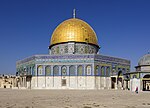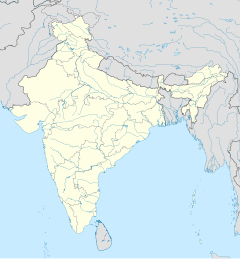1948년 팔레스타인 난민 비행 추정 목록
List of estimates of the Palestinian refugee flight of 1948| 낙바 |
|---|
 |
| 주요 기사 |
| 배경 |
| 주요 사건 |
| 저명한 작가들 |
| 관련 카테고리/목록 |
| 관련 템플릿 |
| 팔레스타인의 역사 |
|---|
 |
| 선사시대 |
| 고대사, 상고사 |
| 고전 시대 |
| 이슬람 통치 |
| 근대 |
| |
이 기사는 1948년 팔레스타인 전쟁 당시 피난했거나 집에서 쫓겨난 팔레스타인 사람들의 수에 대한 유엔의 다양한 중간 및 최종 추정치를 열거하고 있다.그것은 또한 그 기간 동안 팔레스타인 난민들의 수에 대한 다른 중간 및 최종 추정치를 제공한다.
유엔 추정치
이스라엘이 포로로 잡은 지역을 떠나거나 탈출한 사람의 수 추정
- 유엔 조정위원회가 1949년 12월 28일 발간한 유엔 중동 경제조사선교 최종보고서에 따르면 72만6000명.[1][note 1]
- 유엔 조정위원회가 1950년 10월 23일 발간한 유엔 팔레스타인 조정위원회의 일반 경과 보고서 및 보완 보고서에 따르면 1949년 12월 11일부터 1950년 10월 23일까지의 기간을 포괄한다.[5][note 2]
난민등록 총인원 추정치
- 유엔조정위원회가 1961년 10월 2일 발간한 총회 결의 1944호(III) 11항의 이행을 확보하기 위한 유엔 팔레스타인 조정위원회의 노력의 역사적 조사에 따르면 80만~90만 명이다.[6]
- 유엔구호국이 1951년 9월 28일 발간한 근동 팔레스타인 난민 구호사업청 보고서에 따르면, 1951년 6월 난민 87만5998명이 난민으로 나타났다.[7][note 3]
- 유엔구호개발기구 웹사이트에 따르면 1950년 91만4천명의 난민이 발생했다.[9][note 4]
- 유엔구호국이 1951년 9월 28일 발간한 '근동 팔레스타인 난민 구호사업청 보고서'에 따르면 1950년 95만7000명의 난민이 발생했다.[7][note 5]
기타 비행 또는 난민 추정치
- 55만 - 60만 이스라엘 정부 추정치에 따르면 (에프레임 카르쉬에[10] 따르면)
- 월터 피너에 따르면 539,000
- Efraim Karsh에[10] 따르면 583,000 – 609,000
- 조셉 B에 따르면 60만. 셰히트만[12]
- 요람 에팅거에[13] 따르면 63만
- 70만± 베니 모리스의 저서 "팔레스타인 난민 문제의 탄생 재방문"[14]에 따르면
- 어빙 하우와 칼 게르스만에[15][better source needed] 따르면 72만
- 일란 파페에[16] 따르면 75만 명
- Elia Zureik에 따르면, 80만 명 (75만 - 80만 명의 "팔레스타인 개인 정보원"에 따르면, 80만 - 90만 명의 "팔레스타인 숫자" , 85만 명의 "유엔 추정")[citation needed]
- 바하 아부샤크라에[17] 따르면 80만±
- 80만 – Walter Eytan은 1950년 사서에서 1949년 UNRWA 등록을 "어리석은 짓"이라고 언급했지만, "실제 숫자는 80만 명에 가깝다"[18]고 생각했다.
- 살만 아부시타에[19][note 6] 따르면 804,767
- 압델아짐 함마드에[20] 따르면 90만
- 살만 아부시타에[21] 따르면 935,000
중간추정
UN 출처로부터의 중간 추정치:
- 라파엘칠렌토 유엔재난구조프로젝트(DRP) 국장 : 8월[10] 30만35만 명
- 1948년 9월 16일, 유엔 중재자 폴케 베르나도테 백작이 발간한 팔레스타인 유엔 중재자 경과보고서에 따르면, 1948년 9월 36만 명이다.[22][note 7]
- 1948년 10월 18일 유엔 중재자 랄프 번체 대행이 발간한 팔레스타인 중재자 대행진 현황보고서에 따르면, 1948년 10월 47만2000명.[23][note 8]
다른 출처:
- 사무엘 카츠(1973년)[24][25]에 따르면 1948년 5월까지 20만+
- 노암 촘스키(2002년)[26]에 따르면 1948년 5월까지 30만±
- 일란 파페(1994년)[27]에 따르면 1948년 5월 15일까지 38만±
- 유대국민기금의 요세프 웨이츠에 따르면 1948년 6월 5일까지 33만5000명.[28]
- 하가나 정보국의 보고서에 따르면 1948년 6월 1일까지 39만1000명(유엔제명 유대인 국가로부터 23만9000명)[10]
- 에밀 그워시에 따르면 1948년 6월 중순까지 20만 명이다.[10]
- W. De St.에 따르면 7월말까지 30만±중동에 적십자사연맹의 대표인 오빈.[10]
- 에프레임 카르쉬에 따르면, 631,967명이 10월까지 "아랍 리그 추정"이라고 한다.[10]
- Y가 이끄는 이스라엘의 연구에 따르면 10월 말까지 46만 명이 넘는다고 한다.웨이츠와 E.다닌 & Z.리프시츠.[10]
참고 항목
각주
- ^ 유엔 조정 위원회의 이러한 추정은 많은 다른 유엔 문서에서 반복되어 왔다.[2][3]1947년 말 이스라엘 국경 내에 살고 있는 비유대인의 수를 추산하고, 전쟁 후 이스라엘 국경 내에 살고 있는 나머지 비유대인의 수를 뺄셈으로 계산했다.여기에는 약 2만5000명의 국경 난민 – 마을 땅이 이스라엘이 점령한 영토에 위치하고, 마을 집이 아랍 영토에 남아 있어 생계를 잃은 난민들은 포함되지 않는다.이 수치는 나중에 유엔 조정위원회에 의해 71만1000명으로 수정되었다.[4]
- ^ 위원회는 이번 추정이 "상황이 허락하는 만큼 정확하다"고 보고, 구호물자 수가 더 많은 것은 무엇보다도 "이스라엘이 보유한 지역 이외의 지역에서 추방된 자와, 추방되지는 않았지만 빈곤한 자들의 추가" 때문이라고 밝혔다.
- ^ 수치가 부풀려진 것은 "모든 출산은 열심히 발표되고, 가능한 한 모든 곳에서 사망자는 침묵 속에 지나가고, 어떤 경우에도 출산율이 높기 때문에 연간 3만 명의 이름을 순증한다"[8]는 것이다.이 수치는 1951년 6월까지 팔레스타인 탈출 이후 태어난 팔레스타인 난민들의 후손들을 포함한다.
- ^ 수치는 유엔에 제출된 공식 UNRWA 추정치와 일치하지 않는다.
- ^ 추후에 UNRWA에 의해 "많은 허위 및 중복 등록"[8]이 삭제된 후 876,000으로 수정된 수치다.
- ^ 1944년/1945년의 공식 마을 통계를 이용하여 계산한 수치로서, 4년간 순 자연증가율 3.8%를 취하여 1948년/1949년으로 업그레이드하였다.이스라엘에 남아 있는 비유대인의 수는 그 후 총계수에서 공제되었다.
- ^ 수치는 난민으로 등록된 사람들만을 가리킨다.
- ^ 수치는 난민으로 등록된 사람들만을 가리킨다.
참조
- ^ "A/AC.25/6/Part.1". United Nations. 28 December 1949. p. 21. Retrieved 4 April 2014.
- ^ "Right of return of the Palestinian People – CEIRPP, SUPR study". United Nations. United Nations. 1 November 1978. Archived from the original on 21 September 2013. Retrieved 4 April 2014.
- ^ "Anniversaries of significant events in the history of the Palestinian people – Information note". United Nations. 31 December 1987. Archived from the original on 21 September 2013. Retrieved 4 April 2014.
- ^ "A/1367/Rev.1". United Nations. 23 October 1950. Retrieved 4 April 2014.
- ^ "U.N. General Assembly Official Records, 5th Session, Supplement No. 18, Document A/1367/Rev. 1". United Nations. 23 October 1950. Retrieved 4 April 2014.
- ^ "A/AC.25/W/81/Rev.2". United Nations. 2 October 1961. Archived from the original on 7 April 2014. Retrieved 4 April 2014.
- ^ a b "U.N. General Assembly Official Records, 6th Session, Supplement No. 16, Document A/1905". United Nations. United Nations. 28 September 1951. Retrieved 4 April 2014.
- ^ a b "A/1905". United Nations. 28 September 1951. Archived from the original on 7 April 2014. Retrieved 4 April 2014.
- ^ "Who is a Palestine refugee?". UNRWA. Archived from the original on 16 July 2009. Retrieved 4 April 2014.
- ^ a b c d e f g h Karsh, Efraim (2011). "How Many Palestinian Arab Refugees Were There?".
- ^ Pinner, Walter (1959). How Many Arab Refugees: A Critical Study of UNRWA's Statistics and Reports. University of Michigan: Macgibbon & Kee. p. 61.
- ^ Schechtman, Joseph B. (1952). The Arab Refugee Problem. University of Michigan: Philosophical Library.
- ^ Ettinger, Yoram (12 February 2001). "The 1948 Palestinian Refugees – Whose Responsibility?". Jerusalem Cloakroom. Ariel Center for Policy Research. Archived from the original on 20 April 2001. Retrieved 4 April 2014.
- ^ Morris, Benny (2004). The Birth of the Palestinian Refugee Problem Revisited. Cambridge Middle East Studies. Vol. 18. Cambridge University Press. pp. 602–604.
- ^ Howe, Irving; Gershman, Carl (1972). Israel, the Arabs and the Middle East. New York: Bantam. p. 168.
- ^ Pappé, Ilan (October 2006). "The 1948 ethnic cleansing of Palestine Journal of Palestine Studies".
- ^ Abushaqra, Baha (24 October 2002). "The Palestinian Refugee Problem & the Right of Return". Middle East Journal. Archived from the original on 14 June 2006. Retrieved 4 April 2014.
- ^ 모리스 생년월 레게드 p602(p602) : "1950년 말 이스라엘 외무부의 월터 에이탄 국장은 사적인 편지에서 1949년 유엔RWA 등록에 대해 '미처'라고 언급했지만 '실제 숫자가 80만 명에 육박한다'고 생각했다."
- ^ Abu-Sitta, Salman (7 August 2001). "The Unfolding of the Holocaust". Palestine Remembered. Retrieved 4 April 2014.
- ^ Hammad, Abdel-Azim (15 July 1999). "Murder, expulsion – and silence". Al-Ahram Weekly. Archived from the original on 16 July 2012. Retrieved 4 April 2014.
- ^ "Books: 'From Refugees To Citizens At Home: Al Nakba Anatomy'". Palestine Land Society. Archived from the original on 22 September 2015. Retrieved 4 April 2014.
- ^ 유엔 총회 공식 기록, 3차 세션, 보충판 11번, 문서 A/648
- ^ 유엔 총회 공식 기록, 제3차 세션 부록 11A, 문서 A/689
- ^ Katz, Samuel (January 1, 1973). battleground: Fact & Fantasy in Palestine.
- ^ Katz, Joseph E. (1973). "Arab Refugees and the Right of Return". Retrieved 4 April 2014.
- ^ Chomsky, Noam (2002). Understanding Power: The Indispensable Chomsky. New Press. pp. 131–132. ISBN 9781565847033.
- ^ Pappe, Ilan. The Making of the Arab-Israeli Conflict, 1947–51. London: I. B. Taurus. pp. 85, 96.
- ^ David Ben-Gurion, Yoman Hamilhama Tashah-Tashat. Vol. 2. Tel Aviv: Ministry of Defense Publishing House, 1983. p. 487.


